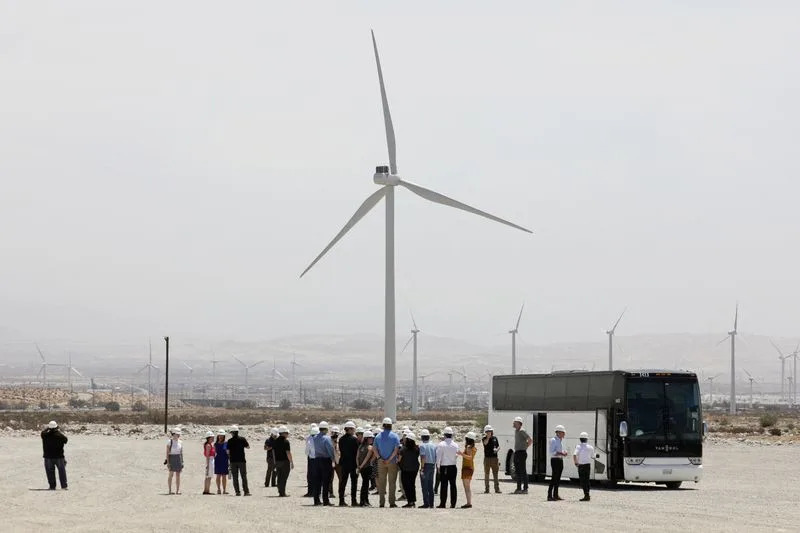Nina Lakhani climate justice reporter
Thu, November 23, 2023
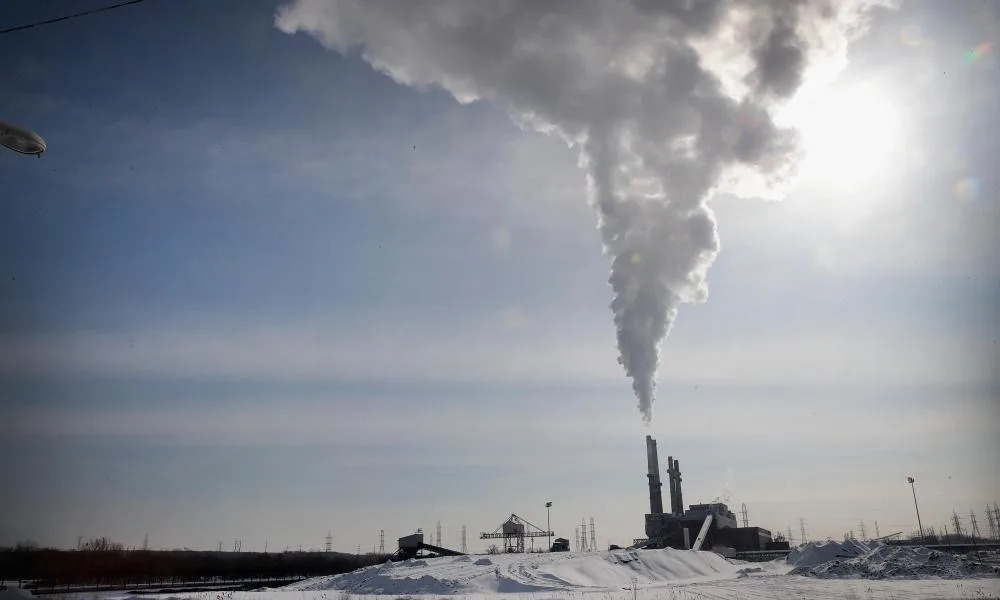
Photograph: Scott Olson/Getty Images
Coal-fired power plants killed at least 460,000 Americans during the past two decades, causing twice as many premature deaths as previously thought, new research has found.
Cars, factories, fire smoke and electricity plants emit tiny toxic air pollutants known as fine particulate matter or PM2.5, which elevate the risk of an array of life-shortening medical conditions including asthma, heart disease, low birth weight and some cancers.
Researchers analyzed Medicare and emissions data from 1999 and 2020, and for the first time found that coal PM2.5 is twice as deadly as fine particle pollutants from other sources. Previous studies quantifying the death toll from air pollution assumed all PM2.5 sources posed the same risk, and therefore probably underestimated the dangers of coal plants.
Related: ‘Insanity’: petrostates planning huge expansion of fossil fuels, says UN report
Government regulations save lives, according to the research, which is published in Science, as most deaths happened when environmental standards were weakest and PM2.5 levels from coal-fired power stations highest.
“Air pollution from coal is much more harmful than we thought, and we’ve been treating it like it’s just another air pollutant,” said the lead author, Lucas Henneman, an assistant professor in the Sid and Reva Dewberry department of civil, environmental and infrastructure engineering at George Mason University. “This type of evidence is important to policymakers like EPA [the US Environmental Protection Agency] as they identify cost-effective solutions for cleaning up the country’s air, like requiring emissions controls or encouraging renewables.”
Henneman led a group of researchers who used publicly available data to track air pollution – and its health effects – from the 480 US coal power plants that operated at some point between 1999 and 2020. A model was used to track the wind direction and reach of the toxins from each power station. Annual exposure levels were then connected with more than 650m Medicare health records that covered most people over age 65 in the US.
The coal plants associated with most deaths were located east of the Mississippi River in industrialized states like Ohio and Pennsylvania, where power stations were historically constructed close to population hubs. But every region had at least one plant linked to 600 deaths, while 10 were associated with more than 5,000 deaths across the study period.

About 85% of the total 460,000 coal plant-related deaths occurred between 1999 and 2007, an average of more than 43,000 deaths per year. The death toll declined drastically as plants closed or scrubbers – a type of sulphur filter – were installed to comply with new environmental rules. By 2020, the coal PM2.5 death toll had dropped 95%, to 1,600 people.
“By linking records of where Medicare beneficiaries lived and when they died, we found that risks due to PM2.5 from coal were more than double the risks related to PM2.5 from all sources,” said co-author Francesca Dominici, a professor of biostatistics, population and data science at the Harvard TC Chan school of public health.
Coal use has declined in the US, but there are still more than 200 coal-fired power plants, accounting for 20% of electricity generation in 2022, according to the US Energy Information Administration (EIA). Indiana, Kentucky and Texas have the most operational coal plants, followed by Illinois, Missouri and Pennsylvania.
Globally, coal-generated power is still rising, with South Africa, China, India and Poland among the countries most dependent on the dirtiest of fossil fuels.
“As countries debate their energy sources – and as coal maintains a powerful, almost mythical status in American energy lore – our findings are highly valuable to policymakers and regulators as they weigh the need for cheap energy with the significant environmental and health costs,” said Dominici.
Mortality burden of air pollution from coal-burning power plants has been underestimated
Between 1999 and 2020, more than 460,000 deaths in the United States were attributable to exposure to air pollution emissions from coal-burning power plants, according to the longest-term national study of its kind. While the findings highlight the increased mortality risks from coal electricity generation, they also underscore the effectiveness of emission-reduction policies in preventing excess death. Exposure to air pollution is associated with poor health and an increased risk of death. Coal-burning electricity-generating units (EGUs), also known as power plants, are a major contributor to poor air quality. Although coal EGU air pollution emissions have declined in the U.S. in recent decades, global coal use for electricity generation is projected to increase. Recent studies have suggested that exposure to fine particulate matter (PM2.5) containing sulfur dioxide (SO2) from coal-burning emissions is more deadly than PM2.5 from other sources. Policymakers seeking to limit the impact of coal use justify regulations by quantifying the health burden attributable to exposure to these sources. However, measuring the magnitude of the impact of coal EGU-derived air pollution on human health, as well as the success of measures to mitigate such impacts, is challenging. Efforts have been hampered by the limited availability of large-scale health databases and source-specific exposure estimates.
To better estimate U.S. deaths attributable to exposure to PM2.5 emitted from coal-burning power plants, and how related mortality patterns have changed over time, Lucas Henneman and colleagues combined a reduced complexity atmospheric transport model, which they used to estimate emissions from 480 individual coal EGUs, with historical individual-level US Medicare death records encompassing more than 650 million person-years. They found that exposure to coal-derived PM2.5 was associated with 2.1 times greater mortality risk than exposure to PM2.5 from all other sources. And, coal-derived PM2.5 was responsible for 460,000 cumulative deaths among those over 65 years of age over the past two decades, accounting for ~25% of the total deaths attributable to PM2.5. According to the findings, the mortality burden of coal PM2.5 has been underestimated. Critically, Henneman et al. also show that the rapid decline of sulfur dioxide (SO2) emissions from coal power plants over the last 20 years – through emissions reduction regulations and coal EGU closures – has led to a large reduction in excess deaths. In a related Perspective, Robert Mendelsohn and Seung Min Kim discuss the study and its limitations in greater detail. Note: The authors have provided an interactive online tool that illustrates how deaths attributed to each individual U.S. coal EGU have changed over time.
JOURNAL
Science
ARTICLE TITLE
Mortality risk from United States coal electricity generation
ARTICLE PUBLICATION DATE
24-Nov-2023
Pollution from coal power plants contributes to far more deaths than scientists realized, study show
Thu, November 23, 2023
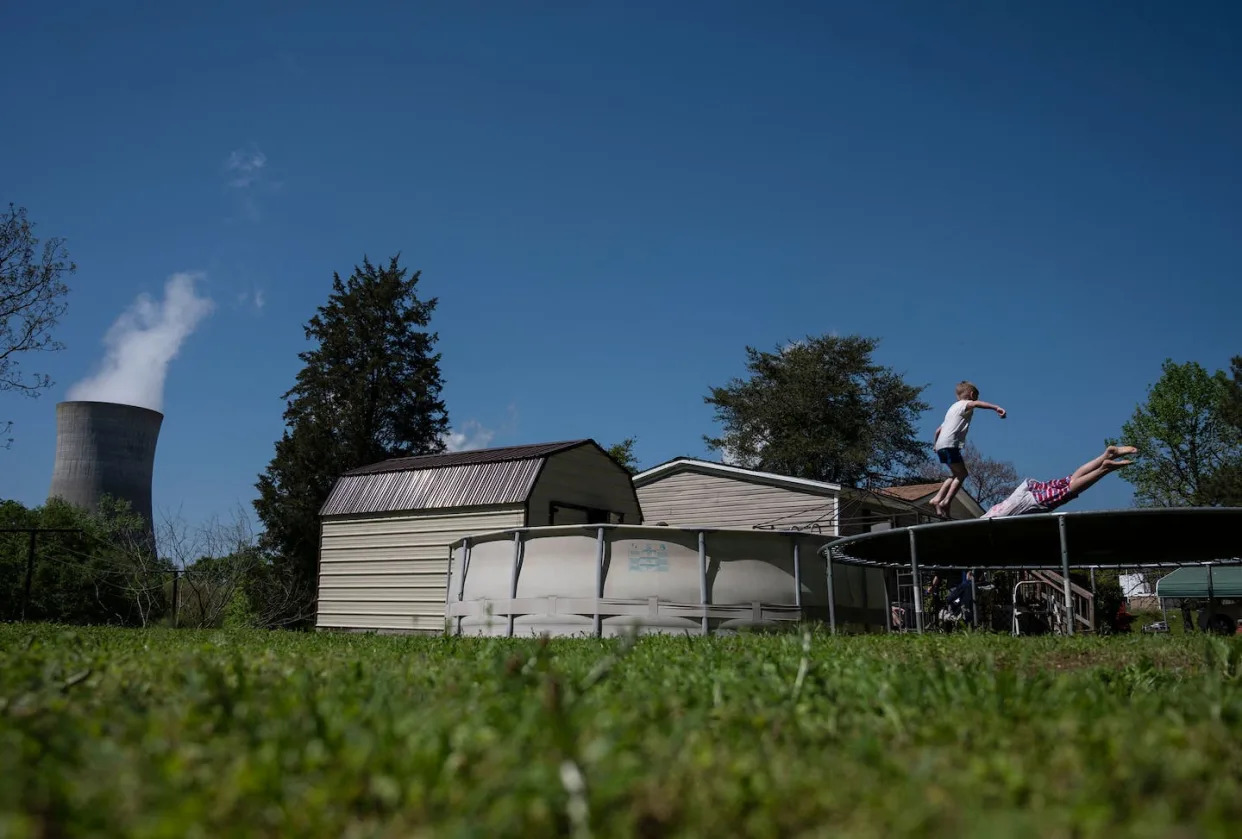
Kids jump on a trampoline as steam rises from a coal power plant in Adamsville, Ala., in 2021. Andrew Caballero-Reynolds/AFP via Getty Images
Air pollution particles from coal-fired power plants are more harmful to human health than many experts realized, and it’s more than twice as likely to contribute to premature deaths as air pollution particles from other sources, new research demonstrates.
In the study, published in the journal Science, colleagues and I mapped how U.S. coal power plant emissions traveled through the atmosphere, then linked each power plant’s emissions with death records of Americans over 65 years old on Medicare.
Our results suggest that air pollutants released from coal power plants were associated with nearly half a million premature deaths of elderly Americans from 1999 to 2020.
It’s a staggering number, but the study also has good news: Annual deaths associated with U.S. coal power plants have fallen sharply since the mid-2000s as federal regulations compelled operators to install emissions scrubbers and many utilities shut down coal plants entirely.
In 1999, 55,000 deaths were attributable to coal air pollution in the U.S., according to our findings. By 2020, that number had fallen to 1,600.

How PM2.5 levels from coal power plants in the U.S. have declined since 1999 as more plants installed pollution-control devices or shut down. Lucas Henneman.
In the U.S., coal is being displaced by natural gas and renewable energy for generating electricity. Globally, however, coal use is projected to increase in coming years. That makes our results all the more urgent for global decision-makers to understand as they develop future policies.
Coal air pollution: What makes it so bad?
A landmark study in the 1990s, known as the Harvard Six Cities Study, linked tiny airborne particles called PM2.5 to increased risk of early death. Other studies have since linked PM2.5 to lung and heart disease, cancer, dementia and other diseases.
Following that research, the Environmental Protection Agency began regulating PM2.5 concentrations in 1997 and has lowered the acceptable limit over time.
PM2.5 – particles small enough to be inhaled deep into our lungs – comes from several different sources, including gasoline combustion in vehicles and smoke from wood fires and power plants. It is made up of many different chemicals.
Coal is also a mix of many chemicals – carbon, hydrogen, sulfur, even metals. When coal is burned, all of these chemicals are emitted to the atmosphere either as gases or particles. Once there, they are transported by the wind and interact with other chemicals already in the atmosphere.
As a result, anyone downwind of a coal plant may be breathing a complex cocktail of chemicals, each with its own potential effects on human health.

Two months of emissions from Plant Bowen, a coal-fired power station near Atlanta, show how wind influences the spread of air pollution. Lucas Henneman.
Tracking coal PM2.5
To understand the risks coal emissions pose to human health, we tracked how sulfur dioxide emissions from each of the 480 largest U.S. coal power plants operating at any point since 1999 traveled with the wind and turned into tiny particles – coal PM2.5. We used sulfur dioxide because of its known health effects and drastic decreases in emissions over the study period.
We then used a statistical model to link coal PM2.5 exposure to Medicare records of nearly 70 million people from 1999 to 2020. This model allowed us to calculate the number of deaths associated with coal PM2.5.
In our statistical model, we controlled for other pollution sources and accounted for many other known risk factors, like smoking status, local meteorology and income level. We tested multiple statistical approaches that all yielded consistent results. We compared the results of our statistical model with previous results testing the health impacts of PM2.5 from other sources and found that PM2.5 from coal is twice as harmful as PM2.5 from all other sources.
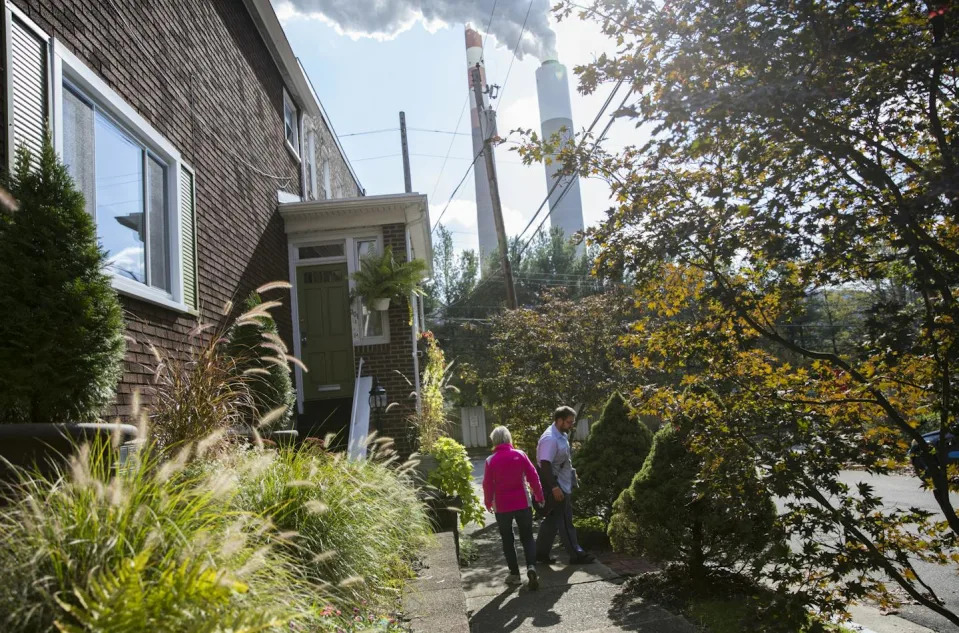
Residents living near the Cheswick coal-fired power plant in Springdale, Pa., publicly complained about the amount of sulfur dioxide, nitrogen oxide and coal particles from the plant for years. Robert Nickelsberg/Getty Images
The number of deaths associated with individual power plants depended on multiple factors – how much the plant emits, which way the wind blows and how many people breathe in the pollution. Unfortunately, U.S. utilities located many of their plants upwind of major population centers on the East Coast. This siting amplified these plants’ impacts.
In an interactive online tool, users can look up our estimates of annual deaths associated with each U.S. power plant and also see how those numbers have fallen over time at most U.S. coal plants.
A US success story and the global future of coal
Engineers have been designing effective scrubbers and other pollution-control devices that can reduce pollution from coal-fired power plants for several years. And the EPA has rules specifically to encourage utilities that used coal to install them, and most facilities that did not install scrubbers have shut down.
The results have been dramatic: Sulfur dioxide emissions decreased about 90% in facilities that reported installing scrubbers. Nationwide, sulfur dioxide emissions decreased 95% since 1999. According to our tally, deaths attributable to each facility that installed a scrubber or shut down decreased drastically.
As advances in fracking techniques reduced the cost of natural gas, and regulations made running coal plants more expensive, utilities began replacing coal with natural gas plants and renewable energy. The shift to natural gas – a cleaner-burning fossil fuel than coal but still a greenhouse gas contributing to climate change – led to even further air pollution reductions.
Today, coal contributes about 27% of electricity in the U.S., down from 56% in 1999.
Globally, however, the outlook for coal is mixed. While the U.S. and other nations are headed toward a future with substantially less coal, the International Energy Agency expects global coal use to increase through at least 2025.
Our study and others like it make clear that increases in coal use will harm human health and the climate. Making full use of emissions controls and a turn toward renewables are surefire ways to reduce coal’s negative impacts.
This article is republished from The Conversation, a nonprofit, independent news organization bringing you facts and analysis to help you make sense of our complex world.
It was written by: Lucas Henneman, George Mason University.
Read more:
3 reasons US coal power is disappearing – and a Supreme Court ruling won’t save it
How poisonous mercury gets from coal-fired power plants into the fish you eat
Soot pollution from coal-fired power plants is more deadly than soot from other sources, study shows
Michael Hawthorne, Chicago Tribune
Thu, November 23, 2023
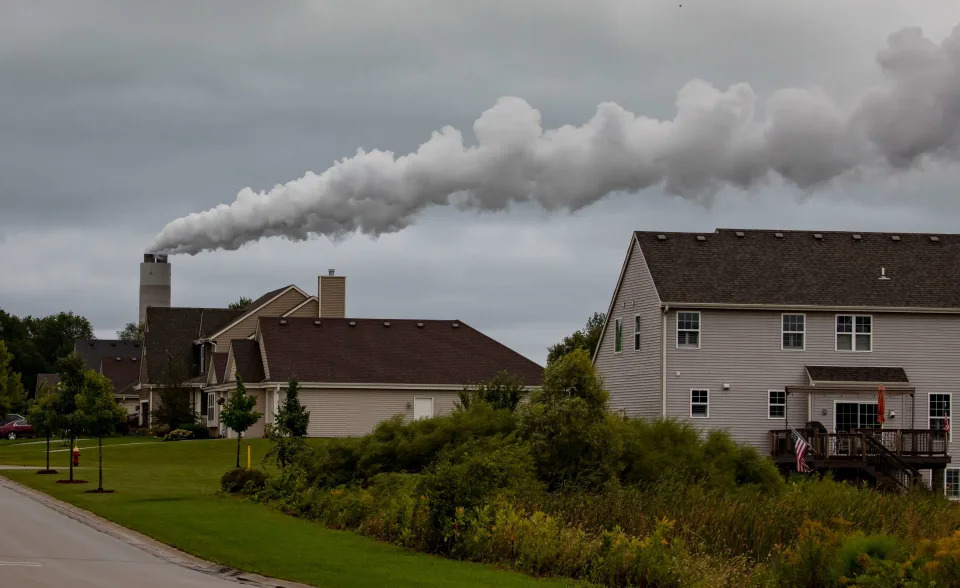

Brian Cassella/Chicago Tribune/TNS
Burning coal to generate electricity is on the way out in the United States, but the nation’s long dependence on the fossil fuel took a devastating toll.
A new study determined for the first time that soot pollution from coal-fired power plants is more dangerous than soot from other sources. During the past two decades, the researchers found, coal plant soot contributed to the deaths of at least 460,000 Americans, including 25% of all deaths among Medicare recipients before 2009.
Only Pennsylvania, New York and Ohio recorded more deaths associated with coal plant pollution than the 25,000 deaths in Illinois during the period studied.
An interactive map accompanying the study, published Thursday in the journal Science, reveals glimmers of hope amid the grim statistics.
Deaths attributed to coal plant soot have declined dramatically in recent years as utilities closed scores of their dirtiest plants and cleaned up others — changes prompted by more stringent federal clean air regulations, competition from less expensive gas-fired power plants and legal pressure from environmental groups.
“The fact that they estimated more than 40,000 deaths a year two decades ago and the number is now down to 1,600 a year is a pretty remarkable success story,” said Jonathan Levy, chair of the Department of Environmental Health at Boston University, who wasn’t involved in the study.
Soot, also known as particulate matter, is a byproduct of incomplete combustion and can be formed by chemical reactions between sulfur dioxide emitted by fossil fuel power plants and other compounds in the atmosphere. The type of soot that most concerns public health researchers — PM 2.5 — is so tiny that thousands of the fine particles could fit on the period at the end of this sentence.
Breathing even small amounts can inflame the lungs and trigger asthma attacks. Previous studies have linked soot exposure with heart attacks and premature death.
The latest study comes as President Joe Biden’s administration is moving to tighten a national limit on soot pollution, which in turn could force new regulations on power plants and other industrial sources.
Utilities fiercely opposed clean air laws for decades. But in one of a series of stark departures from previous debates about anti-pollution rules, the chief trade group for investor-owned utilities appears to be more concerned about how the Biden proposal would be implemented rather than opposing it outright.
“The electric industry has significantly reduced air pollutants such as (sulfur dioxide), (nitrogen oxide), and hazardous air pollutants such as mercury,” Sarah Durdaller, a spokeswoman for the Edison Electric Institute, said in an email. “Additional emissions reductions are expected as the industry continues its clean energy transition.”
A Chicago Tribune review of the new study’s interactive map shows why former President Donald Trump’s attempts to gut the U.S. Environmental Protection Agency, roll back clean air laws and leave regulatory decisions to the states could have made it difficult to continue reducing deaths from coal plant pollution.
For instance, Illinois coal plants were responsible for more deaths associated with soot-related deaths in Wisconsin and Iowa than coal plants in the two other states, the researchers found.

At the same time, the study shows, several Wisconsin coal plants were responsible for more Illinois deaths than those in Wisconsin.
While researchers linked most of the Illinois deaths to coal plants within the state, others as far away as North Carolina, North Dakota and Texas contributed.
“Pollution doesn’t respect state boundaries,” said the study’s lead author, Lucas Henneman, a professor of environmental engineering at George Mason University.
The EPA found similar dynamics at work earlier this year when it took a new look at smog, another type of air pollution.
Chicago and the rest of Cook County are the nation’s worst neighbors when it comes to smog, the EPA concluded in research supporting its proposed “good neighbor rule” pending before the U.S. Supreme Court.
Henneman and his colleagues based their analysis on emissions data reported to the EPA and a massive database of Medicare enrollees. They used well-tested computer models to track how emissions from individual coal plants contributed to soot-related deaths in every state.
In an editorial published in the same issue of Science, researchers at Yale and Columbia said Henneman’s study showed that reducing coal plant pollution has been more beneficial than previously thought.
Though PM 2.5 can’t be seen with the naked eye, the spread of smoke from Canadian wildfires during the summer provided a vivid example of how soot pollution can make the air so dirty that even healthy people have trouble breathing, said Francesca Dominici, a Harvard biostatistics professor who contributed to the study and previously linked soot exposure to COVID-19 deaths.
Bruce Nilles, former director of the Sierra Club’s Beyond Coal campaign, said the declining number of deaths associated with coal plant pollution is a result of a long battle that led utilities to close or announce the retirement of 374 power plants that burned the fossil fuel.
About a fifth of the nation’s electric generation now comes from coal plants, down from more than half a decade ago.
All but two coal plants in Illinois are expected to be closed by the end of the decade. Eight that already have closed in and near Chicago were responsible for 5,660 soot-related deaths between 1999 and 2020, the new study found.
“We’ve come a long way,” Nilles said. “But this study shows there are still some big problems out there, and that means we need the EPA to step in and ensure everyone is protected.”
Particulate pollution from coal associated with double the risk of mortality than PM2.5 from other sources
Key points:
- In an examination of emissions data and Medicare records, researchers calculated that exposure to fine particulate air pollutants emitted by coal-fired power plants (coal PM2.5) is associated with a mortality risk 2.1 times greater than that of PM2.5 from other sources.
- Between 1999 and 2020, 460,000 deaths among Medicare enrollees were attributable to coal-fired power plants; 10 of these plants each contributed at least 5,000 deaths.
- The vast majority of deaths took place between 1999 and 2007, and by 2020 deaths from coal-fired power plants decreased substantially—pointing to the efficacy of regulations on coal PM2.5, researchers say.
Exposure to fine particulate air pollutants from coal-fired power plants (coal PM2.5) is associated with a risk of mortality more than double that of exposure to PM2.5 from other sources, according to a new study led by George Mason University, The University of Texas at Austin, and Harvard T.H. Chan School of Public Health. Examining Medicare and emissions data in the U.S. from 1999 to 2020, the researchers also found that 460,000 deaths were attributable to coal PM2.5 during the study period—most of them occurring between 1999 and 2007, when coal PM2.5 levels were highest.
The study will be published on November 23, 2023, in Science.
While previous studies have quantified the mortality burden from coal-fired power plants, much of this research has assumed that coal PM2.5 has the same toxicity as PM2.5 from other sources.
“PM2.5 from coal has been treated as if it’s just another air pollutant. But it’s much more harmful than we thought, and its mortality burden has been seriously underestimated,” said lead author Lucas Henneman, assistant professor in the Sid and Reva Dewberry Department of Civil, Environmental, and Infrastructure Engineering at Mason. “These findings can help policymakers and regulators identify cost-effective solutions for cleaning up the country’s air, for example, by requiring emissions controls or encouraging utilities to use other energy sources, like renewables.”
Using emissions data from 480 coal power plants in the U.S. between 1999 and 2020, the researchers modeled where wind carried coal sulfur dioxide throughout the week after it was emitted and how atmospheric processes converted the sulfur dioxide into PM2.5. This model produced annual coal PM2.5 exposure fields for each power plant. They then examined individual-level Medicare records from 1999 to 2016, representing the health statuses of Americans ages 65 and older and representing a total of more than 650 million person-years. By linking the exposure fields to the Medicare records, inclusive of where enrollees lived and when they died, the researchers were able to understand individuals’ exposure to coal PM2.5 and calculate the impact it had on their health.
They found that across the U.S. in 1999, the average level of coal PM2.5 was 2.34 micrograms per cubic meter of air (μg/m3). This level decreased significantly by 2020, to 0.07 μg/m3. The researchers calculated that a one μg/m3 increase in annual average coal PM2.5 was associated with a 1.12% increase in all-cause mortality, a risk 2.1 times greater than that of PM2.5 from any other source. They also found that 460,000 deaths were attributable to coal PM2.5, representing 25% of all PM2.5-related deaths among Medicare enrollees before 2009.
The researchers were also able to quantify deaths attributable to specific power plants, producing a ranking of the coal-fired power plants studied based on their contribution to coal PM2.5’s mortality burden. They found that 10 of these plants each contributed at least 5,000 deaths during the study period. They visualized the deaths from each power plant in a publicly available online tool (https://cpieatgt.github.io/cpie/).
The study also found that 390,000 of the 460,000 deaths attributable to coal-fired power plants took place between 1999 and 2007, averaging more than 43,000 deaths per year. After 2007, these deaths declined drastically, to an annual total of 1,600 by 2020.
“Beyond showing just how harmful coal pollution has been, we also show good news: Deaths from coal were highest in 1999 but by 2020 decreased by about 95%, as coal plants have installed scrubbers or shut down,” Henneman said.
“I see this as a success story,” added senior author Corwin Zigler, associate professor in the Department of Statistics and Data Sciences at UT Austin and founding member of the UT Center for Health & Environment: Education & Research. “Coal power plants were this major burden that U.S. policies have already significantly reduced. But we haven’t completely eliminated the burden—so this study provides us a better understanding of how health will continue to improve and lives will be saved if we move further toward a clean energy future.”
The researchers pointed out the study’s continuing urgency and relevance, writing in the paper that coal power is still part of some U.S. states’ energy portfolios and that global coal use for electricity generation is even projected to increase.
“As countries debate their energy sources—and as coal maintains a powerful, almost mythical status in American energy lore—our findings are highly valuable to policymakers and regulators as they weigh the need for cheap energy with the significant environmental and health costs,” said co-author Francesca Dominici, Clarence James Gamble Professor of Biostatistics, Population, and Data Science at Harvard Chan School and director of the Harvard Data Science Initiative.
Funding for the study came from the National Institutes of Health (grants R01ES026217, R01MD012769, R01ES028033, 1R01ES030616, 1R01AG066793, 1R01MD016054-01A1, 1R01ES 034373-01, 1RF1AG080948, and 1R01ES029950); the Environmental Protection Agency (grant 835872); the EmPOWER Air Data Challenge (grant LRFH); the Alfred P. Sloan Foundation (grant G-2020-13946); and the Health Effects Institute (grants R-82811201 and 4953).
“Mortality risk from United States coal electricity generation,” Lucas Henneman, Christine Choirat, Irene Dedoussi, Francesca Dominici, Jessica Roberts, Corwin Zigler, Science, online November 23, 2023, doi: 10.1126/science.adf4915.
###
Harvard T.H. Chan School of Public Health brings together dedicated experts from many disciplines to educate new generations of global health leaders and produce powerful ideas that improve the lives and health of people everywhere. As a community of leading scientists, educators, and students, we work together to take innovative ideas from the laboratory to people’s lives—not only making scientific breakthroughs, but also working to change individual behaviors, public policies, and health care practices. Each year, more than 400 faculty members at Harvard Chan School teach 1,000-plus full-time students from around the world and train thousands more through online and executive education courses. Founded in 1913 as the Harvard-MIT School of Health Officers, the School is recognized as America’s oldest professional training program in public health.
George Mason University is Virginia’s largest public research university. Located near Washington, D.C., Mason enrolled over 40,000 students from 130 countries and all 50 states for the fall 2023 semester. Mason has grown rapidly over the last half-century and is recognized for its innovation and entrepreneurship, remarkable diversity, and commitment to accessibility. Also in 2023, the university launched Mason Now: Power the Possible, a $1 billion comprehensive campaign to support student success, research, innovation, community, and sustainability. Learn more at gmu.edu.
The University of Texas at Austin is a bold, ambitious leader supporting some 52,000 diverse students, 3,000 teaching faculty, and top national programs across 19 colleges and schools. As Texas’ leading research university, UT attracts more than $650 million annually for discovery. Amid the backdrop of Austin, Texas, a city recognized for its creative and entrepreneurial spirit, the university provides a place to explore countless opportunities for tomorrow’s artists, scientists, athletes, doctors, entrepreneurs and engineers.
JOURNAL
Science
METHOD OF RESEARCH
Observational study
SUBJECT OF RESEARCH
Not applicable
ARTICLE TITLE
Mortality risk from United States coal electricity generation
ARTICLE PUBLICATION DATE
23-Nov-2023






